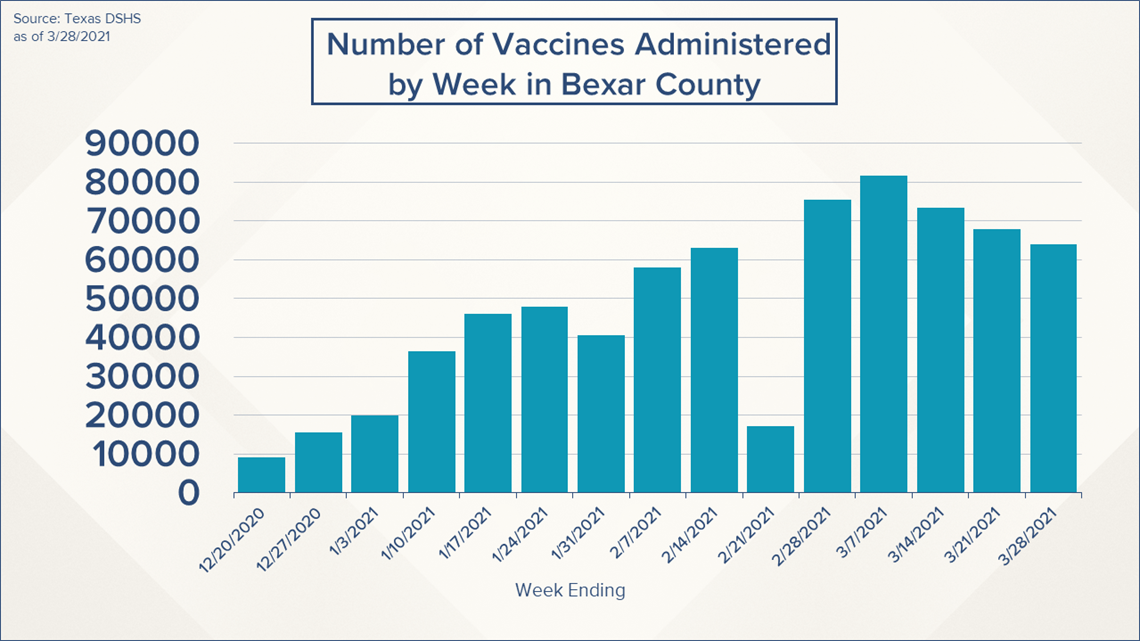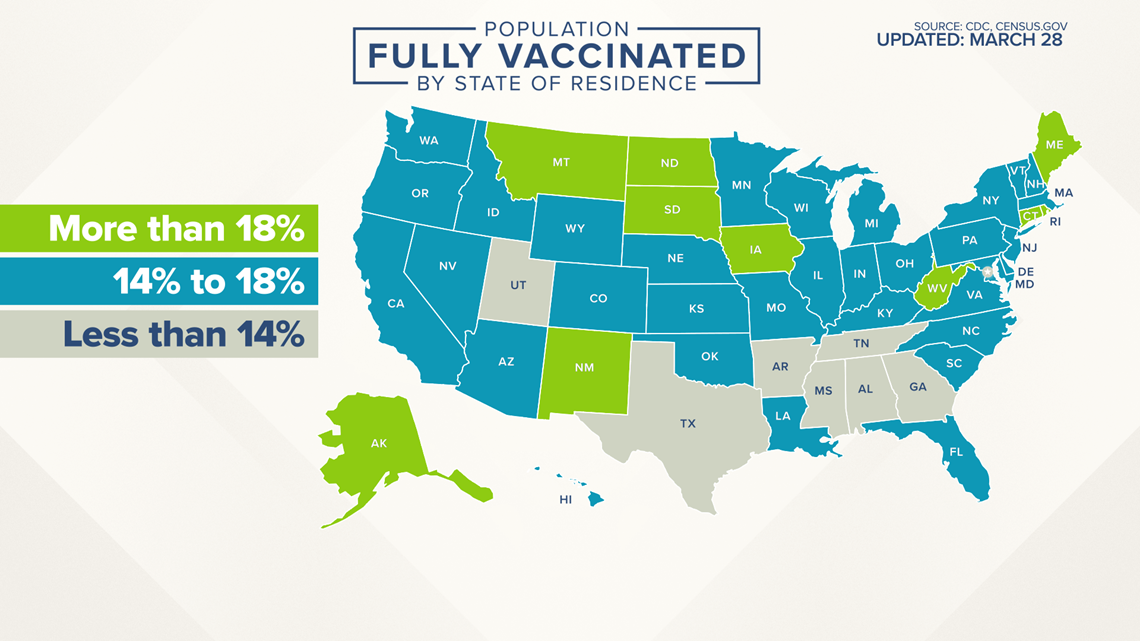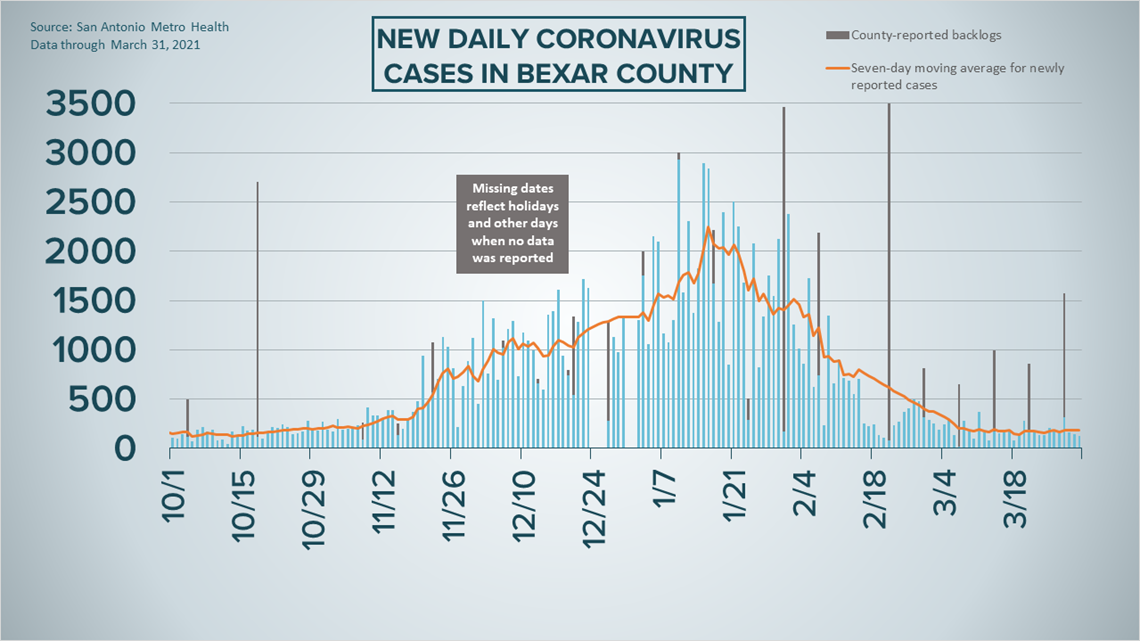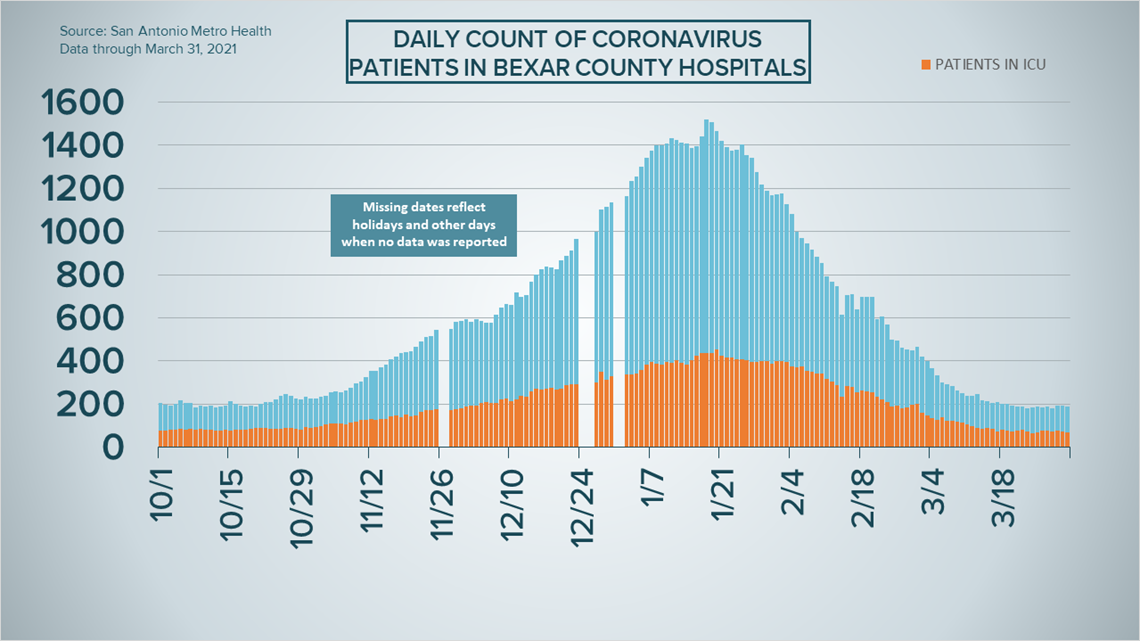SAN ANTONIO — We're tracking the latest numbers from the coronavirus pandemic as well as the vaccine efforts in San Antonio and across Texas.
Latest Coronavirus Numbers
Here are the latest numbers reported by Bexar County officials, as of Wednesday, March 31:
Bexar County:
- 122 new cases were reported, bringing the total number of cases to 205,528.
- 2 new deaths were reported; the county's death remains at 3,150.
- 190 patients currently hospitalized; 29 patients are on ventilators and 68 are in intensive care.
Texas (data as of Tuesday, March 30):
- 4,139 cases reported, including 3,123 new confirmed, 857 new probable, and 159 backlogged cases. More than 2.778 million Texans have been diagnosed with COVID-19 since the pandemic began
- 109 additional deaths were reported, raising the statewide death toll from virus complications to 47,278.
- 3,161 Texans hospitalized, which is up 15 over the previous day.
More county case information is available through the Texas Department of Health Services COVID-19 dashboard.
Vaccine Progress in Bexar County
Across Bexar County, more than 716,000 vaccine doses have been administered, as of March 31.
- 482,043 Bexar County residents have received at least one dose of the coronavirus vaccine, representing 31% of the county's population eligible to receive a vaccination.
- 281,143 Bexar County residents are fully vaccinated, representing 18.1% of the county's population eligible to receive a vaccination.
- 200,900 Bexar County residents (12.9%) are awaiting their second vaccine dose.


DSHS defines "population" as residents who are 16 years of age or older; in Bexar County, this represents more than 1.55 million people. The CDC states that "when a high percentage of the community is immune to a disease (through vaccination and/or prior illness)," that community will have reached herd immunity, "making the spread of this disease from person to person unlikely."
81,284 vaccines were administered last week in Bexar County; a total of 738,290 doses have been administered in the county since vaccination efforts began 15 weeks ago.


Across Texas, 3.972 million residents are fully vaccinated. In total, the state has administered 11.12 million vaccine doses. Texas is one of seven states with less than 14% of its population fully vaccinated, as of March 28:


Bexar County COVID-19 Trends
This week's update of the Warning Signs and Progress Indicators for Bexar County saw Bexar County holding steady at the low-risk level. The positivity rate dropped to 2.1%, a decrease of 0.2% over the last week.
The county's seven-day moving average dropped slightly from 185 on Tuesday to 184 on Wednesday.


The number of COVID-19 patients receiving treatments at area hospitals dropped by three in the last 24 hours to 190. 68 patients are in intensive care, and 29 are on ventilators.


Latest Coronavirus Headlines
Coronavirus symptoms
The symptoms of coronavirus can be similar to the flu or a bad cold. Symptoms include fever or chills, cough, shortness of breath or difficulty breathing, fatigue, muscle or body aches, headache, new loss of taste or smell sore throat, congestion or runny nose, nausea or vomiting, and diarrhea, according to the Centers for Disease Control.
Most healthy people will have mild symptoms. A study of more than 72,000 patients by the Centers for Disease Control in China showed 80 percent of the cases there were mild.
But infections can cause pneumonia, severe acute respiratory syndrome, kidney failure, and even death, according to the World Health Organization. Older people with underlying health conditions are most at risk.
Experts determined there was consistent evidence these conditions increase a person's risk, regardless of age:
- Chronic kidney disease
- COPD (chronic obstructive pulmonary disease)
- Obesity (BMI of 30 or higher)
- Immunocompromised state (weakened immune system) from solid organ transplant
- Serious heart conditions, such as heart failure, coronary artery disease, or cardiomyopathies
- Sickle cell disease
- Type 2 diabetes
- The CDC believes symptoms may appear anywhere from two to 14 days after being exposed.
Human coronaviruses are usually spread...
- Between people who are in close contact with one another (within about 6 feet).
- Through respiratory droplets produced when an infected person coughs, sneezes or talks. These droplets can land in the mouths or noses of people who are nearby or possibly be inhaled into the lungs.
- Some recent studies have suggested that COVID-19 may be spread by people who are not showing symptoms.
Help stop the spread of coronavirus
- Stay home when you are sick.
- Eat and sleep separately from your family members
- Use different utensils and dishes
- Cover your cough or sneeze with your arm, not your hand.
- If you use a tissue, throw it in the trash.
Find a Testing Location
City officials recommend getting a COVID-19 test if you experience fever or chills, cough, shortness of breath or difficulty breathing, fatigue, muscle or body aches, headache, new loss of taste or smell, sore throat, congestion or runny nose, nausea or vomiting, or diarrhea.
Here's a Testing Sites Locator to help you find the testing location closest to you in San Antonio.

